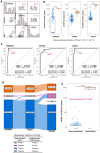Rapid Detection of Anti-IFN-α2 Autoantibodies Using a New Automated VIDAS Assay Prototype
- PMID: 40223598
- PMCID: PMC11995241
- DOI: 10.1002/eji.202451516
Rapid Detection of Anti-IFN-α2 Autoantibodies Using a New Automated VIDAS Assay Prototype
Abstract
Autoantibodies neutralizing Type I interferons increase the risk of severe viral diseases and are linked to autoimmune conditions. The automated VIDAS assay is suitable for anti-IFN-α2 IgGs quantification, offering a swift, reliable, user-friendly, single test for clinical management.
Keywords: VIDAS; autoantibodies; clinical application; single‐sample test; type I interferons.
© 2025 The Author(s). European Journal of Immunology published by Wiley‐VCH GmbH.
Conflict of interest statement
Sylvie Pons, Laurence Generenaz, Nathalie Renard, Valerie Guyot, Cecile Vinit, Fei Zheng, Karen Brengel‐Pesce, and Aurore Fleurie are employees of bioMérieux SA, an in vitro diagnostic company. The other authors declare no conflicts of interest.
Figures


References
-
- Crow Y. J. and Casanova J. L., “Human Life Within a Narrow Range: The Lethal Ups and Downs of Type I Interferons,” Science Immunology 9 (2024): eadm8185. - PubMed
MeSH terms
Substances
Grants and funding
LinkOut - more resources
Full Text Sources

